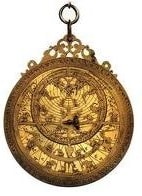What is an Astrolabe?
 An astrolabe is a historical instrument used to predict the position of the sun, moon, planet, and stars. It was perfected during the Islamic Golden Age and the European Middle Ages and Renaissance. Many prominent historical figures (including writer Geoffery Chaucer and possibly ancient astronomer Claudius Ptolemy) have written about or made use of astrolabes. Astrolabes were made of several different disks and star charts. [Read more about Muslim scholars and their inventions.]
An astrolabe is a historical instrument used to predict the position of the sun, moon, planet, and stars. It was perfected during the Islamic Golden Age and the European Middle Ages and Renaissance. Many prominent historical figures (including writer Geoffery Chaucer and possibly ancient astronomer Claudius Ptolemy) have written about or made use of astrolabes. Astrolabes were made of several different disks and star charts. [Read more about Muslim scholars and their inventions.]
Astrolabes and Islam
In the Islamic Golden Age, astrolabes were widely used to determine the qibla, the prayer direction towards Mecca, as well as to pinpoint prayer timings with the movement of the sun. Muslim astronomers also added angular scales in the astrolabes themselves, making it possible to navigate distances.
Furthermore, Muslim astronomers and inventors created the spherical astrolabe, a globe-shaped model of objects in the sky, which consists of rings and lines that symbolized longitude, latitude, and other significant astronomic and geographic features.
The spherical astrolabe was eventually introduced to Europe, where it was used in early astronomical studies. (These inventions also helped the Muslims to perfect celestial globes, an actual globe of the sky, that helped map out stars and constellations.)
The creation and perfection of the astrolabe, as well as the spherical astrolabe and the celestial globe, significantly advanced the early world. It promoted scientific and astronomic exploration, and cultivated new ways of navigation and timekeeping. In the Islamic world, it helped perfect the finding of the qibla. [Click here to learn more about prayer in Islam.]
Mariam “Al-Astrolabiya” Al-Ijliya
Mariam “Al-Astrolabiya” Al-Ijliya is significantly linked with the design of astrolabes. Though Muhammad Al-Fazari is the first Muslim to have helped build an astrolabe in the Islamic world in the eighth century, Al-Ijliya is credited with designing and advancing this instrument.
Though not much is written about Al-Ijliya, we know that she worked in the mid-tenth century (around 944 – 967 AD) in what is now northern Syria. Her work was both creative and innovative. Her father was an apprentice to a well-known astrolabe maker, and she studied under him as his student. She created new designs, which were soon recognized by Sayf Al Dawla, the city’s ruler. In addition, she also helped further navigation and timekeeping techniques.
Al-Ijliya exemplifies that the pursuit of knowledge is encouraged in Islam, and does not discourage women from it. Al-Ijliya is considered a significant scientist in this period of time.
Many these days argue that Islam ‘oppresses’ women or restricts their learning, or, more broadly, that Islam clashes with science. But Al-Ijliya and the Muslims’ influence on astrolabes illustrate that knowledge (scientific and general) are supported by Islam. Because she pursued study and helped innovate new technology for her time, Mariam “Al-Astrolabiya” Al-Ijliya remains a role model until today.

